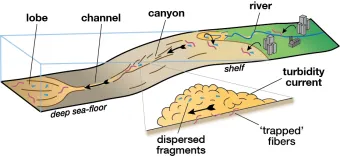
National Oceanography Centre (NOC) research has revealed for the first time how submarine sediment avalanches can transport microplastics from land into the deep ocean. The study also revealed that these flows are responsible for sorting different types of microplastics – burying some, and moving others vast distances across the sea floor.
These findings may help predict the location of future seafloor microplastic hotspots, which in turn could help direct research into the impact of microplastics on marine life.
Over 10 million tons of plastic pollution is exported into the oceans each year. It is thought that around 99% of this is stored in the deep sea, often prefentially accumulating in submarine canyons.
However, it was previously not known how plastic pollution gets to the deep sea from land. The new research, published in the journal Environmental Science & Technology, has shown that microplastics can be moved by gravity-driven sediment flows, which can travel thousands of kilometers over the seafloor..
Alongside colleagues from Utrecht University, in the Netherlands, Durham University, and Manchester University, NOC researcher Dr Mike Clare investigated microplastic transport to and through submarine canyons via these sediment flows. Quartz sand was mixed with microplastic fragments and fibers and released in a flume tank that was designed to simulate real-world flows.
Concentrations of microplastic fragments were more stratified in the flow than microplastic fibers, which settled more slowly. The larger surface to volume ratio of fragments is thought to be the reason they are more evenly distributed. Whereas the concentration of microplastic fibres in sand layers at the base of the flow is thought to be because they get more easily trapped by sand particles.
NOC researcher Dr Mike Clare said this was the aspect of this research that surprised him most: “Considering the size and speed of these flows, you would expect any microplastic fragments within them to be flushed out, yet that isn’t what we found.”
“Counter-intuitively the smaller, lighter microplastic fibres became trapped and buried within sandy deposits that fall out at the base of the flow, whereas the larger microplastic fragments appear to settle out more slowly and therefore become more evenly distributed across the ocean floor.”
Studying the distribution of different types of plastic on the seafloor is important because the size and type of plastic particle determines how toxins build up the surface, as well as how likely it is the plastic will enter the gut of any animal that eats it, and what animal may eat it.
These experiments show that sediment flows have the potential to transport large quantities of plastic pollution from nearshore environments into the deep sea, where they may impact local ecosystems. The next steps for research will involve sampling and monitoring deep-sea submarine canyon, to understand how robustly these experimental findings can be applied to natural systems and the effects on deep-sea ecosystems.
This research forms part of the NOC's broader microplastics research, which aims to understand the extent and implications of microplastic pollution on the health of marine ecosystems.
The paper can be viewed at: https://pubs.acs.org/doi/10.1021/acs.est.9b07527